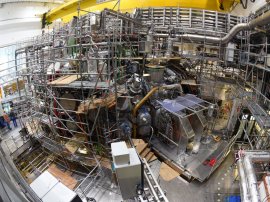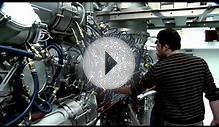
Next week: start with helium plasma planned / hydrogen plasmas are to follow in 2016
With the generation of the first plasma the Wendelstein 7-X fusion device is scheduled to go into operation on time in December 2015 at the Max Planck Institute for Plasma Physics (IPP) in Greifswald/Germany. The experiments will begin with a plasma consisting of the noble gas helium. The Wendelstein 7-X fusion device is the world’s largest and most advanced device of the stellarator type. Its objective is to investigate the suitability of this type for a power plant. Zoom Image
Zoom Image
Photo: IPP, Tino Schulz
After nine years of construction and more than one million installation hours the main assembly of Wendelstein 7-X was completed in April 2014. Since then, preparations for operation have been conducted. One by one the technical systems have been tested – the vacua in the cryostat and the plasma vessel, the cooling system, the superconducting coils and the magnetic field produced by them, the control system as well as the heating and measurement devices.
Subject to the operating licence being granted, the first plasma has been scheduled for 10 December 2015. “We will start with a plasma of the noble gas helium and change, next year, to the actual object of investigation, a hydrogen plasma“, states Project Head Professor Thomas Klinger: “In helium the plasma state is easier to achieve. Moreover, we can use the helium plasmas to clean the surface of the plasma vessel.“ The first hydrogen plasma will follow at the end of January 2016.
Background
The objective of fusion research is to develop a power plant favourable to the climate and environment that derives energy from the fusion of atomic nuclei just as the sun and the stars do. Since the fusion fire only ignites at temperatures over 100 million degrees, the fuel, viz. a low-density hydrogen plasma, ought not to come into contact with the cold walls. Confined by magnetic fields, the fuel is suspended almost free of contact inside a vacuum chamber. For the magnetic cage, two different designs have prevailed, the tokamak and the stellarator. Both of these device types are being investigated by IPP. The ASDEX Upgrade tokamak is being operated at IPP Garching, the Wendelstein 7-X stellarator is located at IPP Greifswald.
Today, only a tokamak such as the ITER international test reactor is trusted to produce an energy-supplying plasma. Wendelstein 7-X, the largest stellarator-type fusion device in the world, will not produce energy. However, the plant is expected to prove the suitability of the stellarator concept for a power station. Wendelstein 7-X is expected to put, for the first time, the quality of plasma confinement on an equal footing with those of a tokamak. And with discharges lasting up to 30 minutes, it should demonstrate the main advantage of stellarators, their ability to operate continuously. In contrast, tokamaks without auxiliary facilities operate in pulsed mode.
Assembly of Wendelstein 7-X began in April 2005: A ring of 50 superconducting magnetic coils approximately 3.5 metres in height, is the key component of the device. Their special shapes are the result of refined optimisation calculations made by the Stellarator Theory division, over a ten year period. The resulting shapes provide a magnetic cage for the plasma with particularly good thermal-insulation properties. The coils are strung along a steel plasma vessel and are enclosed in a ring-shaped steel shell. In its vacuum-pumped interior, the magnets are cooled with liquid helium to superconduction temperature at nearly absolute zero. They then hardly consume any energy. The magnetic field cage generated by them inside the plasma vessel is confining the object of research, the 30 cubic meter of ultra-thin plasma.
The investment costs met by the Federal Government, the State of Mecklenburg-Western Pomerania and the EU added up to 370 million euros. Contracts worth more than 70 million euros were awarded to regional companies. Companies from the whole of Europe produced the components for Wendelstein 7-X. Numerous research facilities at home and abroad were involved in the construction of the device: Within the framework of Helmholtz Association the Karlsruhe Institute of Technology was responsible for the entire microwave plasma heating and the Jülich Research Centre built diagnostics and produced the elaborate connections of the superconducting magnet coils. Specialists from the Polish Academy of Sciences in Krakow carried out their installation. The US fusion institutes at Princeton, Oak Ridge, and Los Alamos made contributions that included auxiliary coils and measuring instruments for equipping Wendelstein 7-X.
YOU MIGHT ALSO LIKE












